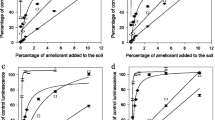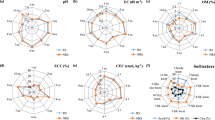Abstract
The potential ecological hazard of metals in soils may be measured directly using a combination of chemical and biological techniques or estimated using appropriate ecological models. Terrestrial ecotoxicity testing has gained scientific credibility and growing regulatory interest; however, toxicity of metals has often been tested in freshly amended soils. Such an approach may lead to derivation of erroneous toxicity values (EC50) and thresholds. In this study, the impact of metal amendments on soil ecotoxicity testing within a context of ion competition was investigated. Four coarse-textured soils were amended with copper (Cu) and nickel (Ni), incubated for 16 weeks and conditioned by a series of total pore water replacements. RhizonTM extracted pore water Cu, Ni, pH and dissolved organic carbon (DOC) concentrations were measured after each replacement. Changes in ecotoxicity of soil solutions were also monitored using a lux-based biosensor (Escherichia coli HB101 pUCD607) and linked to variations in soil solution metal and DOC concentrations, pH and selected characteristics of the experimental soils (exchangeable calcium (Ca) and magnesium (Mg)). Prior to conditioning of soils, strong proton competition produced relatively high EC50 values (low toxicity) for both, Cu and Ni. The successive replacement of pore waters lead to a decline of labile pools of metals, DOC and alleviated the ecotoxicological protective effect of amendment impacted soil solution chemistry. Consequently, derived ecotoxicity values and toxicity thresholds were more reflective of genuine environmental conditions and the relationships observed more consistent with trends reported in historically contaminated soils.


Similar content being viewed by others
References
Antunes, P. M. C., Hale, B. A., & Ryan, A. C. (2007). Toxicity versus accumulation for barley plants exposed to copper in the presence of metal buffers: Progress towards development of a terrestrial biotic ligand model. Environmental Toxicology and Chemistry, 26(11), 2282–2289.
Ashworth, D. J., & Alloway, B. J. (2007). Complexation of copper by sewage sludge-derived dissolved organic matter: Effects on soil sorption behaviour and plant uptake. Water, Air, and Soil Pollution, 182, 187–196.
Ball, D. F. (1964). Loss-on-ignition as an estimate of organic matter and organic carbon in non-calcareous soils. Journal of Soil Science, 15, 84–92.
Bongers, M., Rusch, B., & van Gestel, C. A. M. (2004). The effect of counterion and percolation on the toxicity of lead for the springtail Folsomia candida in soil. Environmental Toxicology and Chemistry, 23(1), 195–199.
Covelo, E. F., Vega, F. A., & Andrade, M. L. (2007). Heavy metal sorption and desorption capacity of soils containing endogenous contaminants. Journal of Hazardous Materials, 143, 419–430.
Dawson, J. J. C., Campbell, C. D., Towers, W., Cameron, C. M., & Paton, G. I. (2006). Linking biosensor responses to Cd, Cu and Zn partitioning in soils. Environmental Pollution, 142, 493–500.
Echevaria, G., Massoura, S. T., Sterckeman, T., Becquer, T., Schwartz, C., & Morel, J. L. (2006). Assessment and control of the bioavailability of nickel in soils. Environmental Toxicology and Chemistry, 25(3), 643–651.
Girotti, S., Ferre, E. N., Fumo, M. G., & Maiolini, E. (2008). Monitoring of environmental pollutants by bioluminescent bacteria. Analytica Chimica Acta, 608, 2–29.
Harter, R. D., & Naidu, R. (1995). Role of metal-organic complexation in metal sorption by soils. Advances in Agronomy, 55, 219–263.
Janssen, R. P. T., Peijnenburg, W. J. G. M., Posthuma, L., & van den Hoop, M. A. G. T. (1997). Equilibrium partitioning of heavy metals in Dutch field soils. I. Relationship between metal partition coefficients and soil characteristics. Environmental Toxicology and Chemistry, 16(12), 2470–2478.
Koster, M., de Groot, A., Vijver, M., & Peijnenburg, W. (2006). Copper in the terrestrial environment: Verification of a laboratory-derived terrestrial biotic ligand model to predict earthworm mortality with toxicity observed in field soils. Soil Biology and Biochemistry, 38, 1788–1796.
Krishnamurti, G. S. R., & Naidu, R. (2003). Solid-solution equilibria of cadmium in soil. Geoderma, 113, 17–30.
Lock, K., Criel, P., de Schamphelaere, K. A. C., van Eeckhout, H., & Janssen, C. R. (2007). Influence of calcium, magnesium, sodium, potassium and pH on copper toxicity to barley (Hordeum vulgare). Ecotoxicology and Environmental Safety, 68(2), 299–304.
Lock, K., Waegeneers, N., Smolders, E., Criel, P., Van Eeckhout, H., & Janssen, C. R. (2006). Effect of leaching and aging on the bioavailability of lead to the springtail Folsomia candida. Environmental Toxicology and Chemistry, 25(8), 2006–2010.
Luo, X.-S., Li, L.-Z., & Zhou, D.-M. (2008). Effect of cations on copper toxicity to wheat root: Implications for the biotic ligand model. Chemosphere, 73, 401–406.
Ma, Y., Lombi, E., Nolan, A. L., & McLaughlin, M. J. (2006). Short-term natural attenuation of copper in soils: Effects of time, temperature and soil characteristics. Environmental Toxicology and Chemistry, 25(3), 652–658.
Meers, E., Du Laing, G., Unamuno, V. G., Lesage, E., Tack, F. M. G., & Verloo, M. G. (2006). Water extractability of trace metals from soils: Some pitfalls. Water, Air, and Soil Pollution, 176, 21–35.
Normandin, V., Kotuby-Amacher, J., & Miller, R. O. (1998). Modification of the ammonium acetate extractant for the determination of exchangeable cations in calcareous soils. Communications in Soil Science and Plant Analysis, 29(11–14), 1785–1791.
Oorts, K., Bronckaers, H., & Smolders, E. (2006). Discrepancy of the microbial response to elevated Cu between freshly spiked and long-term contaminated soils. Environmental Toxicology and Chemistry, 25, 845–853.
Oorts, K., Ghesquiere, U., & Smolders, E. (2007). Leaching and aging decrease nickel toxicity to soil microbial processes in soils freshly spiked with nickel chloride. Environmental Toxicology and Chemistry, 26(6), 1130–1138.
Paton, G. I., Killham, K., Weitz, H. J., & Semple, K. T. (2005). Biological tools for the assessment of contaminated land: applied soil ecotoxicology. Soil Use and Management, 21, 487–499.
Paton, G. I., Viventsova, E., Kumpene, J., Wilson, M. J., Weitz, H. J., & Dawson, J. J. C. (2006). An ecotoxicity assessment of contaminated forest soils from the Kola Peninsula. Science of the Total Environment, 355(1–3), 106–117.
Sauvé, S., Hendershot, W. H., & Allen, H. E. (2000). Solid-solution partitioning of metals in contaminated soils: Dependence on pH, total metal burden and organic matter. Environmental Science and Technology, 34(7), 1125–1131.
Smolders, E., Buekers, J., Oliver, I., & McLaughlin, M. J. (2004). Soil properties affecting toxicity of zinc to soil microbial properties in laboratory-spiked and field-contaminated soils. Environmental Toxicology and Chemistry, 23(11), 2633–2640.
Speir, T. W., Kettles, H. A., Percival, H. J., & Parshotam, A. (1999). Is soil acidification the cause of biochemical responses when soils are amended with heavy metal salts? Soil Biology and Biochemistry, 31, 1953–1961.
Steenbergen, N. T. T. M., Iaccino, F., de Winkel, M., Reijnders, L., & Peijnenburg, W. J. G. M. (2005). Development of a biotic ligand model and a regression model predicting acute copper toxicity to the earthworm Aporrectodea caliginosa. Environmental Science and Technology, 39(15), 5694–5702.
Sumner, M. E. (1999). Handbook of Soil Science. Boca Raton: CRC.
Tandy, S., Barbosa, V., Tye, A., Preston, S., Paton, G., Zhang, H., et al. (2005). Comparison of different microbial bioassays to assess metal-contaminated soils. Environmental Toxicology and Chemistry, 24(3), 530–536.
Thakali, S., Allen, H. E., Di Toro, D. M., Ponizovsky, A. A., Rooney, C. P., Zhao, F.-J., et al. (2006). Terrestrial biotic ligand model. 2. Application to Ni and Cu toxicities to plants, invertebrates, and microbes in soil. Environmental Science and Technology, 40(22), 7094–7100.
Tipping, E., Rieuwerts, J., Pan, G., Ashmore, M. R., Lofts, S., Hill, M. T. R., et al. (2003). The solid-solution partitioning of heavy metals (Cu, Zn, Cd, Pb) in upland soils of England and Wales. Environmental Pollution, 125, 213–225.
Trott, D., Dawson, J. J. C., Killham, K. S., Miah, Md R. U., Wilson, M. J., & Paton, G. I. (2007). Comparative evaluation of a bioluminescent bacterial assay in terrestrial ecotoxicity testing. Journal of Environmental Monitoring, 9(1), 44–50.
Tye, A. M., Young, S., Crout, N. M. J., Zhang, H., Preston, S., Zhao, F. J., et al. (2004). Speciation and solubility of Cu, Ni and Pb in contaminated soils. European Journal of Soil Science, 55, 579–590.
van Gestel, C. (2008). Physico-chemical and biological parameters determine metal bioavailability in soils. Science of the Total Environment, 406, 385–395.
Acknowledgements
This work was funded by the Biotechnology and Biological Sciences Research Council (BBSRC), United Kingdom. Miss Elizabeth E. Diplock is acknowledged for the preparation of amended soils.
Author information
Authors and Affiliations
Corresponding author
Rights and permissions
About this article
Cite this article
Maderova, L., Dawson, J.J.C. & Paton, G.I. Cu and Ni Mobility and Bioavailability in Sequentially Conditioned Soils. Water Air Soil Pollut 210, 63–73 (2010). https://doi.org/10.1007/s11270-009-0224-4
Received:
Accepted:
Published:
Issue Date:
DOI: https://doi.org/10.1007/s11270-009-0224-4




